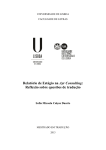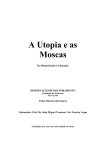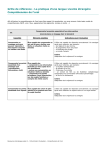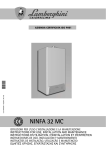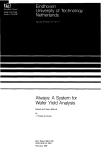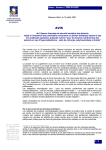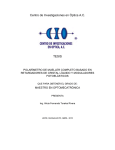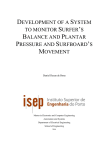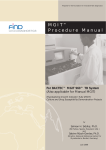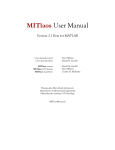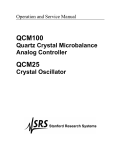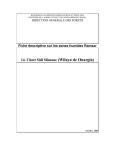Download An Investigation into the Properties of Snail Trails Using a Quartz
Transcript
An Investigation into the Properties of Snail Trails Using a Quartz Crystal Microbalance Claire Edmonds Final Year Project University of Surrey Guildford, Surrey GU2 7XH May 2004 Abstract Thin mucus films have been shown to have hygroscopic properties which are effective in the prevention of bacterial adhesion to polymeric materials. For this reason materials with these properties are used to coat medical implants to achieve the required hydrophilicity needed to repel the bacteria that causes infection. The Hydrophilic surface of Tributyltin self-polishing copolymer paints (TBT-SPC paints) prevents organisms from adhering to ships immersed surfaces in an attempt to hinder marine fouling. Water vapour sorption isotherms of the pedal mucus of the giant African land snail, Achatina Fulica have been studied using a Quartz Crystal Microbalance. Measurements of the frequency of the trail left by the snail were made, which were then used to find the hydrophilicity of the mucus. This was done using the Flory-Huggins polymer/solvent interaction parameter, χ. This parameter is used to describe the interaction between a polymer (the snail mucus in this case) and solvent (water in this case). Two values for χ were obtained; χ = 0.52 ± 0.1 and χ = 0.51 ± 0.1. These values compared well to previous studies. Contents 1 Introduction 1 2 Theoretical Background 2 2.1 2 2 3 4 4 5 2.2 2.3 3 4 5 Pedal Mucus 2.1.1 Structure & Composition Hydrophilicity Quartz Crystal Microbalance 2.3.1 Theory of Operation 2.3.2 Frequency Control with Quartz Crystals Experimental Procedure 8 3.1 3.2 3.3 3.4 3.5 8 8 9 11 11 Collection of Pedal Mucus Relative Humidity Variation QCM Measurements Cleaning the Crystal Variable Angle Spectroscopic Ellipsometry (VASE) Results and Discussion 12 4.1 4.2 4.3 4.4 4.5 4.6 12 12 14 15 15 17 Calibration QCM Result 1 QCM Result 2 VASE Errors Discussion Conclusion Acknowledgements References Other Reading 19 Chapter 1 Introduction 1 Introduction The undesirable accumulation of plants and animals on immersed ship surfaces (known as marine biological fouling) is a natural phenomenon that causes adverse affects on the marine environment. Fouling leads to significant high frictional resistance, which in turn creates an increase in fuel consumption, as well as loss of speed and manoeuvrability. Marine biological fouling also has negative effects on marine life itself, as it is a major factor in the introduction of species into environments where they are not naturally present. The most effective solutions to marine fouling to date are the Tributyltin self-polishing copolymer paints (TBT-SPC paints).1 This paint has a hydrophilic surface which prevents organisms from adhering to the ships immersed surfaces. In a similar situation, the polymeric materials that are regularly implanted into the human body are subject to bacteria colonising their surfaces, hence risk of infection. This colonisation of bacteria to the implants is believed to be due to hydrophobic adsorption; lowering the hydrophobicity of these surfaces will reduce the bacterial adhesion. This approach can be taken in reducing protein adsorption and cell adhesion in implants. The implants are coated with polymeric surfactants to achieve the required hydrophilicity needed to repel the bacteria.2 Mucin is a polymer with a structure consisting of a thread-like protein back bone and densely packed carbohydrate side-chains.2 The adsorption of mucins onto different types of surface is very important in biomaterial applications. Extensive studies have been carried out in order to understand the behaviour of the mucins when in contact with these surfaces.3 The hydrophobic property of the back bone causes them to adhere to hydrophobic surfaces, whilst the hydrophilic carbohydrate side-chains repel microbes that attempt to colonise those hydrophobic surfaces. These properties make mucin a very good candidate for the coating of medical devices.4 The mucus secretions of a Mollusc, far from being simple slime, are a highly functional and important group of bio-materials. Despite the diversity of Molluscan mucus secretions, apart from knowing that the primary content is water, little is known about the chemical and mechanical properties of these materials.5 This report investigates the pedal mucus of the East African land snail Achatina Fulica using a Quartz Crystal Microbalance. Measurements of the water vapour sorption of the pedal mucus will be taken in order to estimate the hydrophilicity. The thickness of the mucus film will be measured in order to obtain the density, and hence some estimate of the structure of the pedal mucus. Claire Edmonds Final Year Project 1 Chapter 2 Theoretical Background 2 Theoretical Background 2.1 Pedal Mucus The mucus secretions of molluscs are used in reproduction, digestion, defence against predators, protection of eggs or young plus many other important functions. Many gastropods secrete mucus onto the surface of the foot, using it as an aid in movement as well as a means of adhering to the surface on which it crawls. In addition, the most evident use of mucus in gastropods is the trail of pedal mucus left behind, which is used either as a homing device, or as a means of locating a mate. 5 All gastropods use a muscular foot, with secretions of pedal mucus, to achieve locomotion. The muscular foot provides the force for movement, and the mucus secreted by the sole of the foot acts as a lubricant between the foot and the surface over which it is moving. Studies of mud snails show that slugs and snails will only follow the trail of their own species, and also that the trail indicates direction of travel.7 The presence of molluscs has been thought to have a detrimental effect on the settlement of organisms. Therefore, a better understanding of the functionality of pedal mucus could lead to a means of controlling the reproduction of snails, hence limiting their impact on agricultural areas, especially vegetable crops.6 A pedal mucus trail is reported to be in the range of 10-20 µm when freshly deposited. This dries to leave a much thinner, solid film as the mucus typically consists of between 90.1% and 99.7% water.5 2.1.1 Structure & Composition Molluscan pedal mucus is a highly hydrated complex of inorganic salts, protein and polysaccharide organic material.8 These protein-polysaccharide molecules are highly expanded and enfold the whole volume of the mucus, even at low concentrations. The viscosity, elasticity and other mechanical properties vary between different Molluscan mucins. Whilst present knowledge of the molecular structure of Molluscan mucus is too limited for an accurate model to be drawn, alternative models of mucins with similar mechanical properties can be used to gain some idea of structure: Four units are held together to form a large, globular composite. These composites interact in solution to form a gel network.5 Figure 2.1: A schematic diagram of the basic molecule of pig gastric mucus. Claire Edmonds Final Year Project 2 Chapter 2 Theoretical Background 2.2 Hydrophilicity Membranes in an aqueous environment either have an attractive or repulsive response to water. The composition of the membrane and surface chemistry determine whether it is attracted to water (hydrophilic) or repulsed (hydrophobic). The chemical properties of a hydrophilic material allow a water film or coating to form on the surface. The term literally means "water-loving"; Materials which have an affinity for water, or are able to readily absorb water are characterised as hydrophilic. Hydrophilic materials also possess a high surface tension value and have the ability to form hydrogen-bonds with water. The presence of active groups determines the ability of the material to form these hydrogen bonds. The greater the propensity for a material to connect with water through hydrogen bonding, the more hydrophilic the material will be. Hydrophobicity is the opposite of hydrophilicity; hydrophobic materials possess low surface tension values and lack active groups in their surface chemistry for formation of hydrogen-bonds with water. “The contact angle is a measurement of the angle formed between the surface of a solid and the line tangent to a droplet (on a surface) radius from the point of contact with the solid.” (GE Infrastructure Water and Process Technologies). A contact angle between 0 and 90 results in spreading of the drop, whereas angles greater than 90° indicate the liquid tends to bead or shrink away from the solid surface; A contact angle between 0 and 90 suggests a hydrophilic material and an angle greater than 90 suggests a hydrophobic material. See figure 2.2 below. Figure 2.2: The contact angle of hydrophilic/hydrophobic materials In order to quantify hydrophilicity, a polymer must be in equilibrium with water. Water will move from a material with a higher relative humidity (RH) to a material with a lower RH until equilibrium is reached. This equilibrium can be easily reached under laboratory conditions, but is not so easily achieved in an open environment where there will be a continuous movement of water molecules so the material may never reach equilibrium.4 Claire Edmonds Final Year Project 3 Chapter 2 Theoretical Background When the polymer is in equilibrium with water in an atmosphere that has an activity a, the hydrophilicity can be quantified using the Flory-Huggins expression4 : ( ln a = ln øW + 1 – 1/N ) (1 - ø ) + χ ( 1 - ø ) W W 2 2.1 Where χ is the Flory-Huggins polymer-solvent interaction parameter (χ is a measure of hydrophilicity), øW is the volume fraction of water sorbed by the polymer, N is the number of water molecules that are required to equal the volume of the polymer molecule and a is the activity which is calculated by a = RH% 100% 2.2 where RH is the Relative Humidity.4 Flory–Huggins theory is a modified lattice theory for polymer solutions which takes into account the large differences in dimensions between solvent and polymer molecules. The thermodynamic quantities of the solution are derived from a simple concept of combinatorial entropy of mixing and a reduced Gibbs energy parameter, the ‘ χ parameter’.9 Using the Flory-Huggins equation it is possible to account for the equilibrium thermodynamic properties of polymer solutions, particularly in swelling of thin polymer films in a solvent vapour.10 This is a very useful expression as it allows us to model the water uptake using just one parameter, χ; The higher the χ value, the more hydrophobic the polymer is.6 2.3 Quartz Crystal Microbalance (QCM) 2.3.1 Theory of Operation Crystals which acquire a charge when compressed, twisted or distorted are said to be piezoelectric. In 1880, Pierre and Jacques Curie observed that when pressure was exerted on a small piece of quartz, an electrical potential was seen between the deformed surfaces, and that this applied voltage affected physical displacements.11 This was the discovery of the piezoelectric (pressure electric) effect. The electric potential provides a transducer effect between electrical and mechanical oscillations. Large piezoelectric coefficients are required for this; rochelle salt produces a comparatively large voltage upon compression and was used in early crystal microphones. Piezoelectric materials are also used widely as highly stable oscillators for frequency control, this calls for mechanical and thermal stability.11 Quartz demonstrates this property and is extremely stable. Quartz crystals are used for watch crystals and for precise frequency reference crystals for radio transmitters. Claire Edmonds Final Year Project 4 Chapter 2 Theoretical Background The Quartz Crystal Microbalance (QCM) is an extremely sensitive mass sensor, capable of measuring mass changes in the nanogram range. The sensitivity of the QCM is approximately 100 times higher than an electronic fine balance with a sensitivity of 0.1 µg. This means that QCM’s are capable of measuring mass changes as small as a fraction of a monolayer or single layer of atoms.11 QCM’s are piezoelectric devices consisting of a thin plate of quartz with electrodes, (usually made of gold, platinum or titanium) fixed to each side. An oscillating electric field is applied to the crystal, which makes it oscillate back and forth mechanically. The direction of the oscillations depends on how it is cut. The first quartz crystal controlled oscillators were based on Xcut crystals, which are very temperature sensitive. Figure 2.3: The Quartz Crystals Therefore, the X-cut crystals are nowadays used in applications where the large temperature coefficient is of little importance, such as transducers in space sonar’s. This problem was overcome in 1934 when the Ambient Temperature (AT)-cut quartz crystal was introduced. This has the advantage of having a very stable resonant frequency and almost zero frequency shift if the surrounding temperature is approximately room temperature.4 In this investigation we used AT-cut crystals with gold electrodes. By tracking the resonant frequency of a quartz crystal, it is possible to study the formation of thin films such as proteins, polymers and cells onto surfaces in liquid. In liquid, an adsorbed film may consist of a considerably high amount of water, which is sensed as a mass uptake by a QCM. 2.3.2 Frequency Control with Quartz Crystals The resonant frequencies of a typical mechanical vibrational system, along with some other physical parameters are determined by the total mass of the vibrating body. This means that when material is added to or removed from the body, a change in resonant frequency can be observed.11 This can be used for mass determination. From the very beginning of using quartz crystal resonators as frequency control elements it was common to increase the frequency of the resonator by drawing pencil marks on the electrodes, or decreasing the frequency by rubbing of some electrode material with an eraser. The understanding of this mass induced frequency shift was only known on a qualitative basis. However, in 1959 Sauerbrey Claire Edmonds Final Year Project 5 Chapter 2 Theoretical Background published a paper that showed that the frequency shift of a quartz crystal resonator is directly proportional to the added mass. This work is generally taken as the breakthrough and first step towards a quantitative tool to measure very small masses.11 A simplified model of the QCM. (a) at resonance, the wavelength is equal to half of the quartz plate thickness. (b) An increase in thickness results in an increase in wavelength, hence a decrease in the resonant frequency. (c) the mass of the deposited film is treated as an equivalent increase in quartz crystal mass. Figure 2.4: Idealised physical model of the QCM For a quartz crystal to oscillate, the following must be satisfied tq = λq / 2 2.3 where tq is the thickness of the quartz crystal plate and λq is the wavelength of shear-mode elastic wave in thickness direction In terms of resonant frequency, fq (the frequency of the bare crystal) and the shear wave velocity, vq, using the equation for the speed of a wave (v = fλ) equation 2.3 can be written as fq tq = vq / 2 2.4 and the resonant frequency shift dfq caused by an infinitesimal change in crystal thickness dtq is dfq / fq = -dtq / tq 2.5 The negative sign of equation 2.5 shows that as the thickness of the quartz crystal plate increases (i.e. a film is placed on it) the resonant frequency is reduced. Equation 2.5 can also be expressed in terms of quartz crystal mass Mq and mass change dMq dfq / fq = -dMq / Mq Claire Edmonds Final Year Project 2.6 6 Chapter 2 Theoretical Background Sauerbrey then made the assumption that a small change in mass can be treated as a small mass change of the quartz crystal itself. Equation 2.6 can be written in approximation form: (fc – fq) / fq = -mf / mq 2.7 where mf and mq are the mass per unit area of a thin film and bare crystal respectively, and fc is the resonant frequency of the crystal with the deposited material. The areal density (mass per unit area) of the film is equivalent to the product of thickness and density, using this and equation 2.4, equation 2.7 becomes mf = -(fc – fq) ρq vq / 2fq2 2.8 where ρq is the quartz crystal density. This is often simply expressed as ∆f = -Cf mf 2.9 Where ∆f = fc – fq (frequency shift) and Cf = 2 fq2 / (ρq vq) and is defined as the mass sensitivity or calibration constant of QCM.11 So the frequency shift is proportional to the mass deposited on the film. Using this relationship we can calculate the water mass fraction sorbed by the film by dividing the mass of water by the total mass of the wet film.4 ømw = fc (RH) – fRH (0%) 2.10 fc (RH) – fq (RH) Claire Edmonds Final Year Project 7 Chapter 3 Experimental Procedure 3 Experimental Procedure 3.1 Collection of Pedal Mucus The pedal mucus to be investigated was that of the commonly seen East African species Achatina Fulica. This was recognised by its pointed apex (top of shell).12 Gastropods are one of the most adaptable of all types of animals, the Giant African snail is one of 22,000 terrestrial species which have adapted to almost every type of environment, including captivity. This, along with regular human handling meant that the snails were accustomed to their habitat and did not produce defensive mucus when samples were taken. The snails were kept in a plastic tank lined with compost. They were fed daily on fresh fruit and vegetables and were given calcium to keep up the strength in their shells by means of a cuttle fish. The pedal mucus was collected by placing the snail on a sheet of bench coating, which was plastic coated so allowed the snail to glide over it easily. The snail was left to crawl across the paper, allowing all the compost and other debris to be removed from the foot. Once the foot was clean, a bare crystal was placed in the path of the snail with some food at the opposite end to entice the snail across the crystal. Several attempts at this were made until enough mucus was collected onto the crystal to be analysed. As the pedal mucus is made up of at least 90% water, the deposit on the crystal dried rapidly. 3.2 Relative Humidity Variation The amount of water vapour in the air at any given time is usually less than that required to saturate the air. A salt solution in an air tight container maintains a constant humidity in the air above it of less than that of pure water. The salt molecules dilute the water and hinder the escape of water molecules into the atmosphere.7 Different salts have different affinities for water, so can be used to vary the water vapour pressure in the air. The higher the affinity for water the salt has, the more water will be diluted and less water molecules will be able to escape into the air. This gives a low relative humidity: Relative humidity = actual vapour pressure saturation vapour pressure x 100% 3.1 The relative humidity can also be related to the activity of the water, a by RH = a x 100 3.2 By varying the humidity of the atmosphere around the pedal mucus on the quartz crystal, the water uptake of the film was studied. The relative humidity was controlled using saturated salt solutions. This had the advantage of being cheap and easy to set up. Salt solutions are also effectively Claire Edmonds Final Year Project 8 Chapter 3 Experimental Procedure independent of temperature fluctuations.7 The solutions were prepared carefully; a supersaturated slushy solution of each salt was made by adding the salt to deionised water in a Petri dish, salt was added until no more could be dissolved in the water. It was important to ensure that the solution was so saturated that no un-saturated water lay on the top. It was also ensured that no salt residue was left on any of the dishes, and that no salt crystals penetrated the surface by leaving a solution 2mm thick of saturated water on the surface of the solution. In order to produce a wide range of humidity the following salts were used.4 Salt Lithium Chloride LiCl Magnesium Chloride MgCl2 Potassium Carbonate K2CO3 Sodium Bromide NaBr Potassium Iodide KI Sodium Chloride NaCl Potassium Bromide KBr Ammonium Sulphate (NH4)2SO4 Potassium Chloride KCl RH% at 25°C 11.2 32.8 43.2 57.6 68.86 75.3 80.9 81.0 84.3 Figure 3.1: Table of salts and their documented relative humidity Silica gel has an extremely high affinity for water and so was used to create an environment with a 0% relative humidity. 3.3 QCM Measurements The QCM used in this investigation was a research quartz crystal microbalance (RQCM) made by MAXTEK, INC This has 3 main parts – The QCM main panel, the crystal holder and the quartz crystal itself. These can all be seen in figure 3.1. The crystal used in this investigation was an AT-cut gold coated quartz crystal with a resonant frequency of 5Mhz. The crystal was one inch in diameter with a density of approximately 2650 kg/m3.11 An RQCM has a mass resolution of < 0.4 ng/cm2, a frequency resolution of 0.03 Hz at 6.0 MHz and a gain accuracy of +/- 0.01% at 25°C.13 Figure 3.2: The Research Quartz Crystal Microbalance (RQCM) Claire Edmonds Final Year Project 9 Chapter 3 Experimental Procedure The equipment was set up as in figure 3.2 below. Figure 3.3: Arrangement for measurements with QCM The crystal was placed in the crystal holder, which was connected to the RQCM and then placed in an air tight container along with the relevant salt solution. The relative humidity inside the container was monitored with a hygrometer until equilibrium was reached (an equal number of water molecules were evaporating from the surface of the water into the air as were condensing from the air back into the water). It was not assumed that the relative humidity would reach the exact literature value stated above, but a value within 3% was considered an accurate measure. This took between 2 and four hours. Once the humidity had stabilised, a measurement of the frequency could be taken. The frequency took between 20 minutes and an hour to stabilise. Firstly, measurements of the frequency of the bare quartz crystal were taken at each different relative humidity in order to check that the crystal was not affected by humidity and to collect some base results. The pedal mucus was then deposited onto the quartz crystal and left to dry. It was placed in the crystal holder and then air tight container with the silica gel and the frequency measurements were taken as above. The frequency was then recorded in the same way for all of the other RH’s using the salt solutions in turn from lowest (LiCl) to highest (KCl). This process was then repeated, but going from the highest RH to lowest, for the same film on the crystal. The crystal was cleaned as described in section 3.4 and coated in a new film before repeating the whole experiment again. Claire Edmonds Final Year Project 10 Chapter 3 Experimental Procedure 3.4 Cleaning the Crystal In order for the second round of measurements to be accurate, the crystal had to be cleaned carefully. The gold electrode was very delicate, so care had to be taken not to scratch or remove any of it as this would result in a poor connection. The crystal was soaked in 10% Decon solution overnight. It was then rinsed carefully with deionised water and its frequency checked with the RQCM to ensure it was free of any residue.4 3.5 Variable Angle Spectroscopic Ellipsometry (VASE) The Variable Angle Spectroscopic Ellipsometry (VASE) used in this experiment was manufactured by J.A Woollam Co, VASE instruments. VASE was used to determine the thickness of the mucus absorbed on the crystal, using a broad band high pressure Xenon arc lamp. It can scan over the wavelength range 200-1100nm by varying the angle to look for the best angle and wavelength for the highest accuracy. VASE was calibrated according to the manual before each scan was performed. It was then aligned correctly and set up to scan between angles 65° and 75° using 100 rotations of the analyser. Firstly, a scan of the bare quartz crystal was taken to set a reference for the fitting model. The data from this was saved in the software. A scan of the quartz crystal with the film deposit on it was then taken and the two were compared using a dispersion model within the software. The film thickness was varied in order to obtain the best-fit model. The software also gives an option to vary the thickness non-uniformly, in order to compensate for an uneven coverage of the film deposit. Claire Edmonds Final Year Project 11 Chapter 4 Results & Discussion 4 Results & Discussion 4.1 Calibration Initial attempts at measurements were unsuccessful, as the RH appeared to be taking excessive amounts of time to settle. After being left overnight for over 18 hours, it was still not anywhere near the literature value for any of the salt solutions attempted. The salt solutions were disposed of and new ones were made, taking extra care to follow the precautions when making the salt slush solution. This did not make any difference to the RH reading, so after consulting the manual, it was decided to re-calibrate the Hygrometer. This was done using Hanna mini-calibration chamber; containing two sealed chambers and two different types of salt, one with LiCl (11.2% RH) and the other with NaCl (75.3% RH. The RH probe was first immersed in the LiCl RH chamber and allowed to stabilise, this took approximately 4 hours. The meter was then adjusted using the humidity trimmer to read 0.0% RH. This procedure was then repeated with the high RH chamber, adjusting it to a value of 64.3% RH. Lastly, this was left for one hour and then adjusted to 75.3% RH whilst still in the NaCl chamber. After testing with the salt solutions again, the RH settled within the required 3% of the literature value. 4.2 QCM Result 1 The collected sample on the crystal went through 20 runs and the frequency was measured at the end of each run. Firstly, the sorption cycle (frequency noted for each RH starting from lowest to highest) was measured, and then the desorption cycle (high RH to low RH). Equation 2.10 was then used to calculate the water mass fraction sorbed by the film. By plotting the water content of the film against the relative humidity we can compare the data collected to the theoretical behaviour of the film as described by Flory-Huggins theory. This theory is described in section 2.2 by equation 2.1. This equation relates the solvent content of the film to the chemical potential using the Flory-Huggins parameter, χ. A macro was created which set an initial value of 0.5 for χ which was then varied to find the best fit value for the data. The assumption was made that in N in equation 2.1 is a very large number, making (1/N) ~ 0, so the equation becomes ( ln a = ln øW + 1 - øW ) +χ (1-ø ) W 2 4.1 Figure 4.1 shows the sorption desorption cycle of the film. A best-fit value for χ was performed using the Flory-Huggins equation with Gen Plot software. The fit obtained is shown in figure 4.2. The estimated value for the polymer/solvent interaction parameter using this method was 0.52 ± 0.1. Claire Edmonds Final Year Project 12 Chapter 4 Results & Discussion 60 Low to High RH High to Low RH Water Mass Fraction (%) 50 40 30 20 10 0 -10 -20 0 20 40 60 80 100 Relative Humidity (%) Figure 4.1: Film 1 sorption and desorption cycles 1.0 Activity 0.8 0.6 0.4 0.2 0.0 0.0 0.1 0.2 0.3 0.4 0.5 0.6 Water Mass Fraction Figure 4.2: Best-fit value for the Flory Huggins Parameter Claire Edmonds Final Year Project 13 Chapter 4 Results & Discussion 4.3 QCM Result 2 The experiment was repeated with a fresh film in order to confirm the results and to try and deduce an idea of the errors involved in the measurements. New salt solutions were also prepared to ensure that these didn’t not affect any of the measurements. Figure 4.3 shows the sorption desorption cycle of the second film. The best-fit obtained for the Flory-Huggins parameter is shown in figure 4.4. The estimated value for the polymer/solvent interaction parameter for the second film was 0.51 ± 0.1, which is very close to the first value, and well within the errors. 60 Low to high RH High to low RH Water Mass Fraction (%) 50 40 30 20 10 0 -10 -20 0 20 40 60 80 100 Relative Humidity (%) Figure 4.3: Film 2 sorption and desorption cycles Claire Edmonds Final Year Project 14 Chapter 4 Results & Discussion 1.0 Activity 0.8 0.6 0.4 0.2 0.0 0.0 0.1 0.2 0.3 0.4 0.5 Water Mass Fraction Figure 4.4: Best-fit value for the Flory Huggins Parameter 4.4 VASE The aim of this part of the investigation was to discover an estimate for the thickness of the film, which could then be used to determine the density, giving some idea of the structure of the mucus. The scans were taken and the parameters were varied to try to find the best-fit for the data. This proved difficult, as the film on the crystal was fairly thick. Varying all parameters whilst keeping within realistic values could not give us a precise value for the thickness of the film, but a range of values could be determined. This range gave the thickness of the film to be between 100 and 170nm. 4.5 Errors Accuracy is the most important specification of any device. The high sensitivity of the QCM means we can be confident that our measurements have minimalistic error involved in them. For the QCM, the water mass fraction is determined from the change in resonant frequency, so the accuracy of the measurement is affected by 3 factors: errors introduced by the frequency measurement employed, errors due to changes in resonant frequency from factors other than the mass, such as temperature or stress, and errors in the Claire Edmonds Final Year Project 15 Chapter 4 Results & Discussion accuracy of the formula used to convert the formula from frequency to water mass uptake.11 The errors introduced by the frequency measurement are reduced by limiting the period of measurement to a relatively short time interval. Once the humidity had stabilised, which took up to 4 hours, the frequency was left for 20 minutes to settle. To get an accurate estimate of this error, some reproducibility checks were carried out. This involved taking 10 measurements of the frequency of a crystal coated in a uniform film under identical conditions and determining the difference in the values recorded. The crystal used was soaked in toluene overnight and then dried in the fume cupboard for 1 hour. The crystal was placed in the holder at room temperature (22°C in this case) and at a relative humidity of 40%. The temperature and relative humidity were kept stable, the frequency was left for 20 minutes to stabilise and then a measurement was taken for 5 minutes. After this, the maximum and minimum values of the frequency over the 5 minutes were noted. This was repeated 10 times, so that 10 pairs of measurements were obtained. These are shown in table 4.5 below. Maximum Frequency Reading (Hz) 4991934.47 4991937.35 4991938.25 4991936.51 4991936.81 4991937.21 4991935.76 4991938.51 4991938.38 4991935.62 Minimum Frequency Reading (Hz) 4991933.58 4991935.08 4991936.01 4991934.51 4991935.62 4991936.94 4991934.26 4991935.32 4991937.42 4991934.43 Difference in Reading (Hz) 0.89 2.27 2.24 2.00 1.19 0.27 1.50 3.19 0.96 1.19 Table 4.5: Reproducibility measurements The mean difference in the readings above is 1.57 Hz, which when measuring in MHz is a very small amount and would not make a significant difference to our results. The standard deviation on the maximum frequency is 1.33 and the standard deviation on the minimum frequency is 1.21. This shows that there is a very small error involved in the readings taken from QCM due to the measurement of the frequency itself. From this we can assume that the measurements taken for the experiment are correct ± 2 Hz. The error in resonant frequency due to factors other than the mass was controlled by placing the crystal and holder in an airtight container during the measurements. This meant that the relative humidity was kept as constant as possible once it had stabilised. Also when mixed with water, some of the salts gave of heat in a chemical reaction, and so they were left to cool completely Claire Edmonds Final Year Project 16 Chapter 4 Results & Discussion before putting them in the container, as this would affect the temperature of the measurement environment. Also, in order to minimise stress on the crystal, when placed in the holder, the lid was tightened to approximately the same place every time the crystal was removed and put back in. Assuming that all of these precautions are taken, the main error in the results is determined by the formula used to convert frequency to water mass fraction sorbed by the film. In this case, our theory assumes an evenly deposited film, completely covering the active area of the quartz crystal resonator.11 This proved very difficult to achieve, and discontinuations in the film could have lead to discrepancies in the measurements. Another limitation of the Flory-Huggins theory is that it neglects to account for changes in structure caused by the water sorption, chemical heterogeneity and the complexity of specific interactions with sorbed water. It is also believed that that mucus is slightly cross-linked, the effects of which are not considered in equation 2.1. 4.6 Discussion Figure 4.1 shows the sorption-desorption cycles of the pedal mucus. The water content of the film increased from 0.0% for a dry film at 0% RH, up to 56.93% at 84.4% RH. This result compares well to the second result gained in this investigation, shown in figure 4.3, where the water content of the film increased from 0.0% for a dry film, to 51.59% for a RH of 82.9%. Both of these results compare well to work done previously.6 Some hysteresis can be seen in the isotherms of figures 4.1 and 4.2. This is due to the film going through a denaturation process (an alteration of the native structure causing a loss of biological activity). Figure 4.1 shows good reproducibility at all RH values, with only a slight deviation at approximately 50% RH. Elsewhere, experiments on mucins from other mammals have found a strong hysteresis in water vapour sorption.14 The least squares fit of χ for the data gave the best fit when χ = 0.52 ± 0.1. The agreement between the experimental data and the fit is very good. This indicates that the mucus is very hydrophilic. Previous work on the pedal mucus of African land snails6 has found values of χ to be 0.52 ± 0.1, which compares very well to the result gained in the investigation. It is helpful at this stage to compare the results gained with values of χ for other polymers. Experiments on BSM (bovine sub maxillary mucin) and PGM (porcine gastric mucin) have found χ = 0.45 and χ = 0.62 respectively.4 Also, measurements on thin films or PVP using a quartz crystal microbalance found χ = 0.51 ± 0.03.6 Our result suggests that the molecules in the mucus retain their hydrophilicity after the denaturation process. It also suggests that the cross-linking in the Claire Edmonds Final Year Project 17 Chapter 4 Results & Discussion mucus is not particularly high, otherwise the water uptake would be restricted and our value for χ would be a lot higher than 0.52 because there would have been less swelling. The measurement of the thickness of the film using VASE was disappointing. The parameters were varied and a fit was attempted, but a discrete value for the thickness of the film could not be determined. A good fit of the data could only be achieved when some of the parameters (such as refractive index) were set to unreasonable values, which would not give an accurate measure of thickness. The software gave an option to vary the thickness non-uniformly, in order to compensate for an uneven coverage of the film deposit, when this was set to 100%, which is not at all ideal and does not give an accurate measure, the fit was still poor. However, the thickness was estimated to be between 100 and 170 nm with a thickness non-uniform of 60%. A better method of collecting the mucus so that it is a thin, evenly distributed film would need to be found in order to advance in this area. Claire Edmonds Final Year Project 18 Chapter 5 Conclusion 5 Conclusions QCM provided a simple yet effective method of determining the water vapour sorption of the pedal mucus. The accuracy and sensitivity of the equipment meant that the measurements were taken with confidence The parameter χ is a gauge of the interaction energy between a polymer (the snail mucus) and water. The higher its value, the more hydrophobic the polymer is. The water content of the mucus trail of the African land snail is a direct function of the relative humidity. The mucus absorbed significant amounts of water, showing 56.93% water content at 84.4% RH. The experimental data showed a good fit to the theory, and it was possible to compare the two using the Flory-Huggins theory and changing a single parameter, χ. Values of χ = 0.52 ± 0.1 and χ = 0.51 ± 0.1 were found which compared very well to previous results for snail mucus, as well as fitting in well with results from other mucins. The experimental set up worked well and gave reproducible results. This relied on a number of time consuming procedures. The proper preparation of the salt solutions was very important as this controlled the relative humidity of the measurement. The main problem with this was that the solution needed to be at exactly the right slushy composition for an accurate measurement of the humidity to be taken, and also that a significant amount of time was needed before the environment had reached the correct relative humidity. If possible, the method of the collection of pedal mucus would need to reexamined in order to carry on the investigation. The theory assumes a uniform, continuous film on the crystal for accurate results. This was not always possible, as it relied on the snail crawling across the crystal. Attempts were made to collect the mucus using a pipette to gently stroke the foot of the snail, but this was unsuccessful as the snail went back into their shells when touched. If it was possible to create a uniform film, the thickness could be measured and more could be discovered about the structure of the mucus. The investigation could then be extended to include other mucins, such as that fro a marine snail, in order for a comparison to be made. The hydrophilicity of the snail mucus might influence the trailing and homing mechanisms of the snail, as well as possibly providing anti-bacterial properties for protection. Claire Edmonds Final Year Project 19 Acknowledgements Acknowledgements I would like to thank my project supervisor, Dr Joe Keddie for all of his help conducting the experiments and interpreting the results. Thanks also to Ibraheem Bushnak who taught me how to use the QCM equipment and to Dr Helen Richardson for her support in the lab. Lastly I would like to thank my family and friends for all of their support and encouragement throughout the duration of this project. Claire Edmonds Final Year Project 20 References References 1. D. Meseguer Yebra, S. Kiil, K. Dam-Johansen “Antifouling technology – past, present and future steps towards efficient and environmentally friendly antifouling coatings” Progress in Organic Coatings (2004) Article in Press 2. L. Shi, R. Ardehali, K. Caldwell, P. Valint “Mucin coating on polymetric material surfaces to suppress bacterial adhesion” Colloids and Surfaces B: Biointerfaces 17 (2000), pages 229-239 3. A. Dedinaite, L. Bastardo “Interactions between Mucin and Surfactants at Solid-Liquid Interfaces” Langmuir 18 (2002), pages 9383-9392 4. I. Bushnak “Characterization of Bovine Submaxillary Mucin and Porcine Gastric Mucin using QCM and Ellipsometry” Masters Thesis; University of Surrey, Physics Department, Guildford, Surrey (2003) 5. K. M Wilbur “The Mollusca” P.W. Hochachka, Vol 1 “Metabolic Biochemistry & Molecular Biomechanics” M. Denny, Chapter 10 “Molecular Biomechanics of Molluscan Mucous Secretions” Academic Press 1983, pages 431-465 6. B.J. Lincoln, T.R.E. Simpson, J.L. Keddie “Water vapour sorption by the pedal mucus trail of a land snail” Colloids and Surfaces B: Biointerfaces (2003) Article in Press 7. B.J. Lincoln “An Investigation of Equilibrium Swelling in Thin Mucus Films Using IR Spectroscopic Ellipsometry” Final Year Project; University of Surrey, Physics Department, Guildford, Surrey (May 2003) 8. C. Brereton, W.A. Housea, P.D. Armitage, R.S. Wotton “Sorption of pesticides to novel materials: snail pedal mucus and blackfly silk” Environmental Pollution 105 (1999) pages, 55-65 9. IUPAC Compendium of Chemical Terminology 2nd Edition (1997) 10. R.J. Young, P.A. Lovell “Introduction to Polymers” second edition, Chapman and Hall 1996, Cambridge Press, pages 141-145 11. C. Lu, A.W. Czanderna “Applications of Piezoelectric Quartz Crystal Microbalance” 1984 Elsevier Science Publishers, Amsterdam 12. L. Mann “How to Care for Your Giant African Land Snail” (2002) Kingdom Books 13. Maxtek, Inc “Operation and Service Manual RQCM Research Quartz Crystal Microbalance” First Edition (2002) Claire Edmonds Final Year Project 21 References Other Reading 14. F. Bettelheim, A. Block, Biochimica et Biophysia Acta 165 (1968) 405 15. H.D, Gesser, Donald R.T. Lafreniere “A Drag Reducing insoluble hydrophilic marine coating” Progress in Organic Coatings 49 (2004) pages 379-374 16. F. A. Bettleheim, S.H. Enrlich “Water Vapor Sorption of Mucopolysaccharides” Chemistry Department, Adelphi College, Garden City, NY (1963) 17. F. A. Bettleheim, A. Block “Water Vapor Sorption of Bovine and Porcine Submaxillary Mucins” Biochemica et Biophysica 165 (1968) pages 405409 18. B.Santelices, M. Bobadilla “Gastropod pedal mucus retains seaweed propagules” Journal of Experimental Marine Biology and Ecology, 197 (1996) pages 251-261 Claire Edmonds Final Year Project 22
























